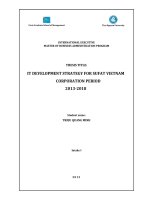Cs224W 2018 7
Bạn đang xem bản rút gọn của tài liệu. Xem và tải ngay bản đầy đủ của tài liệu tại đây (3.99 MB, 9 trang )
CS224W Project Final Report
Yuetong Wang, Jack Jin, Alice Zheng
Stanford University, Stanford, CA 94305
, ,
Dec
1
2018
Introduction
Transportation system is one of the most common types of networks we interact within daily
life. Neither economic growth nor technological revolution could happen without a properly
designed transportation system. In this project, we are going to explore the railway system in
China for passenger transportation and investigate its robustness. In particular, we designed
a possible criterion for measuring that robustness: Given the list of trains, and a number k,
if we are allowed to destroy a maximum of k railroad blocks, what is the maximum influence
that we could get? We will investigate some possible algorithms for calculating this criterion,
compare their results.
2
Related
Work
There are plenty of existing work discussing the robustness of transportation systems, but
work investigating the robustness of a railway network is a bit lacking. Therefore we looked at
papers on the robustness of general transportation for inspiration. For example, Robustness
Tests for Public Transport Planning argues that the traditional bi-criteria of cost and
quality do not suffice the need to evaluate a transportation planning system and introduces
a third criteria to measure robustness. The paper proposes three different robustness tests
that can be conducted on a transportation schedule, and discusses their intricacies with
experiments. Although the paper discusses a completely different transportation system and
focuses on planning, the idea of a robustness test helped us to formulate our own research
question.
Additionally, we also looked at papers on graph clustering and optimization algorithms to
help with the design of our own algorithms. For example, Graph based k-means clustering”!
discusses the running graph clustering using the k-means algorithm as an alternative to other
methods such as minimal spanning trees. Clustering algorithms could reveal the underlying
structure of our network,
more, since our question
optimization algorithms.
discusses the application
and shows that MCMC
also potentially produce
and help us in finding a solution to our research question. Furtheris essentially an optimization problem, we also looked at papers on
Markov chain Monte Carlo methods applied to graph clustering)Ì
of MCMC algorithm on graph clustering and flow optimization,
can not only reduce the computation time for such problems but
better results.
3
context
Define
3.1
Define
The
railroad map
the
the
“railroad
map”
is an undirected graph
G =
and F indicating all the “primitive railroads”.
(V,£)
with V indicating all the stations
An edge (u,v) exists if and only if there’s
a block of railroad directly connecting the two stations u and v, with no other stations in
the middle. The weight of an edge is defined to be the length of this railroad block. In
the Data Collection and Preprocessing section, we will explain on how to estimate this
value.
3.2
Define
the
“trains”
Trains could be viewed as simple paths on the graph. In the
only see all the stations that the specific train stops at, but it
other stations between two stops. Between two stops, we assume
path with shortest distance (if there are ties, randomly pick one,
reality).
4
Define
the
dataset we have, we could
could actually pass many
that the train follows the
and ties rarely happen in
Problem
Here is the problem that we are tackling in the next several sections: Given the list of trains,
and a number k, if we are allowed to destroy a maximum of k railroad blocks, what is the
maximum influence that we could get?
To further clarify the problem:
(i) Each train has an “importance”, which is defined to be the time for a complete trip
times a speed coefficient. The speed coefficient is a constant for each type of trains
- this is indicated in the name of that train. For example, a train starts with G will
have a higher speed coefficient than a train starts with T. The reason for not using
the distance travelled is that we don’t have a precise dataset about this.
(ii) Each train has a fixed route (a simple path on the graph).
is destroyed, the whole train is affected.
If any edge on this path
(iii) The total influence is the sum of importance of all affected trains.
We believe this problem to be interesting for a variety of reasons:
(i) It is a good measure of the vulnerability of the system. There are many algorithms
targeting at measuring vulnerability based on the single-failure assumption (e.g. Biconnected component detection for the detection of bridges and articulation vertices).
However, we want to extend the scope to a multiple-failure case. It can serve as a
metric to evaluate “how should we make this system more robust”.
(ii) Both the railroad map and the trains are engaged in this problem, making the result
more realistic. It’s hard to tell the importance of different parts of the railroad map by
looking at the map itself; however, trains give us more information, as the density of
trains will indicate the importance in general.
(iii) The problem is not trivial. If custom railroad map and trains are allowed, it’s not hard
to prove that the original problem is NP-complete, by reducing it to the vertex-cover
problem. We’re looking for approximation algorithms.
5
Data Collection and Preprocessing
5.1
Recovery
of the Railroad
map
We obtained two sets of data online. The first is a list of all the Chinese railway stations,
including the station name and the geographical location (in longitude and latitude). Notice:
in China, no two railway stations have the same name. The second data set is s list of all
trains currently in operation. For each train, there is a list of all the stations visited in order,
and the time needed to travel between any consecutive pairs of stations. Then we recover
the railroad map using the algorithm below. Notice that this is not meant to be an exact
recovery, but should be a good enough approximation:
(i) Iterate through each train.
Assume that the current train has t stops a1, d2,---
,a;. We
add edges (a;,a,;) for alli+1
(because we already know that there’s a station in the middle).
(ii) Iterate through each train again. Now, for each pair of consecutive stops (a;,a;41), add
an edge between these two stops if and only if it does not appear in the “impossible
set” 7
This algorithm is based on the assumption that, for each railroad block (u,v), at least one
train stops at both stations. This is a reasonable assumption given that there are many local
trains. This assumption also facilitate the process of estimating the length of a block of road
- proportional to the minimal possible time for a train to travel from wu to v (this information
is available - we know that when will each train stop at each station). The estimation of
length is not that ideal, given the design of China’s railway system - some railroads are
dominantly for High-speed trains, while some railroads do not have High-speed trains at all.
However, this is the best estimation we could come up with.
The result map we got is pretty sparse. It has 2576 vertices and 3075 edges. Figure 1
demonstrates the degree distribution of this graph. Given the nature of the railroad map,
it’s not surprising that all vertices have super low degree; most of them actually have a
degree of 2, indicating that they are just “chain” together.
5.2
Track
the route
of a train
This problem could be reduced to a pairwise shortest path algorithm, according to the
assumption that each train will travel the shortest path between two consecutive stops.
Here’s a slight variation of this idea so that it facilitates us in solving the problem:
(i) Calculate the pairwise distance using Queue-based Bellman-Ford.
using Floyd is that the graph is too sparse.
The reason for not
(ii) For each train, enumerate all the pairs of consecutive stops. For each two consecutive
stops (x,y) and each railroad (u,v), if dist|x, u] + len(u,v) + distlv,y] = dist|ax, y], or
dist|x, v] +len(v, u)+distlu, y] = dist[x, y], then the railroad (u,v) will affect this train.
(iii) Now, for each edge (u,v), we get a set of trains that will be affected.
The problem then becomes: pick a set of k edges, calculate the total importance of trains
affected, and maximize this total importance.
6
Algorithms
6.1
Greedy
This problem has a very similar format compared to the Influence maximization problem.
Inspired by that, we describe the following algorithm:
(i) Initially, the set of edges chosen is empty.
(ii) Each time, pick the edge that will maximize the marginal gain. Intuitively,
increase of total influence should be as large as possible after each edge added.
the
(iii) Repeat this process k times.
Interestingly, the simple greedy algorithm performs surprisingly well on the realistic data Of course, we noticed this only after we designed and implemented several other algorithms.
Figure 2 demonstrates the result. To understand the result, we see that the total influence
on the entire graph (when we remove all edges) is 9546151.5, so it’s possible to disable over
75% of the railway network capacity by destroying only 20 edges in the network.
Degree distribution of all stations
le7
Total influence as railroads destroyed
1600 +
1400 +
os 4
8
a
°
6
# of stations
_
°
œ
°
°
So
=
# of trains affected
°
=
rs
a
A
L
1200 4
°
k
N
°
oS
1
0.2 4
4
6
degree
8
10
Figure 1: Degree Distribution
6.2
T
0
T
20
T
T
40
60
# of railroads destroyed
T
80
T
100
Figure 2: Result Achieve by Greedy
Dividing the Graph
In the above algorithm, we ignore the underlying structure of the trains - they are all paths
on some graph we know. The trains affected by each edge is not a random set! Therefore,
we decide to leverage this information and design some new algorithms.
Usually, if greedy algorithm could not get an ideal result, it’s stuck
and “lose the big picture”. The following algorithm is inspired by
since the railroad graph is almost planar, we would like to find
dividing the graph into K clusters. We only destroy one edge
intuitively there’s some kind of “global coordination”. Here is the
on some local maximum
the K-Means algorithm:
AK centers of the graph,
in each cluster, so that
algorithm:
(i) Define the weight of each edge to be a constant c minus the number of trains affected
by it. Calculate the pairwise shortest distance based on this metric.
(ii) Random sample Kk nodes as the initial center.
(iii) For each node, assign it to the center that it’s closest to.
(iv) For each center, re-calculate the optimal center based on the nodes assigned to it. Go
back to (iii), iterate this process until convergence.
(v) Now we get K clusters. Greedily add edges as we did before (“maximize marginal
gain”), but each cluster could only contribute one edge. The order of clusters are
random.
In the above algorithm, intuitively, we want to identify the clusters with largest train density.
Unfortunately, we didn’t see this algorithm outperforms the greedy one, as shown in Figure
3.
Nevertheless, it does successfully identify the clusters and their centers. Without prior
knowledge, the centers calculated by this algorithm are usually the major “railway junction”
cities in China. Some of the stations that appear the most frequently are: Zhengzhou,
Comparison between Greedy and K-Means
41 Comparison between Greedy and Mountain Climbing
Agee RENEE
|
mountain-climbing result / greedy result
0.0010 +
K_means result / greedy result
Boo
“nes greedy
0
20
40
60
K
80
0.0008 +
9.0006]
eo
mountain-climbing
greedy
0.0004 +
0.0002 +
0.0000 +
100
Figure 3: K-means v.s. Greedy
0
20
40
K
60
80
100
Figure 4: Greedy with Mountain Climbing
Hankou/Wuchang!, Beijing,
depends on K. If K is 3 or
China - North, East, South,
cities are usually detected.
Sometimes there are multiple
Notice that, among the 2576
junctions, but this algorithm
Shanghai, Nanjing, Guangzhou, Chengdu. The result really
4, usually the result is like one major city from each part of
Central/Central West. If A is around twenty, the top largest
If K is larger, some “local” junctions will also be included.
stations from the same city, and only one of them will appear.
stations, only a small amount of them are stations of major
could detect them reasonably.
6.3.
Mountain
Railroad-based
Climbing
Given that our attempt to “coordinate globally” was not very successful, we decided to
go back to the original greedy algorithm, but incorporate the graph structure inside the
algorithm.
One way to improve the greedy algorithm is through local search (we call it Mountain
Climbing; it’s fundamentally the same as MCMC). We start with the greedy algorithm, but
each time, we randomly “twist” the current result by a little bit; if we get a better result,
then that will be the new “current result”, while if we get a worse result, we accept it with
a certain probability depending on how worse it is.
Here is the full algorithm:
(i) Initialize with the result obtained from greedy.
(ii) Each time, we “twist” in the following way: move an edge to one of its neighboring
edges. If we detect that we’re moving on a chain, keep moving in that direction until
we reach the end. Also, remember the last time when this edge was moved; don’t move
back.
'Hankou
Wuhan
and Wuchang
are two stations located very close to each other, both belonging to the city of
Degree distribution of all stations, compressed
Railroad Importance
1000000
+
' 600000 ]
i
N
So
©
# of stations
800000 +
*
400000 4
200000 +
0
2
4
6
8
degree
10
12
14
16
01
0
Figure 5: Degree Distribution of Compressed
Network
500
1000
1500
Railroad part, sorted by importance
2000
Figure 6: Influence of Each Edge
(iii) If the new result is better, accept it. Otherwise, accept it with probability 0.5 * e”™?.
is some constant about the scale of the answer; in this problem, we pick 7 = 0.01 after
experiments.
This algorithm could achieve better result on larger K’s. The improvement is not much,
though (mainly because the answer itself is too large). Figure 4 shows this result.
7
Analysis
We see that the greedy algorithm performs very well and other proposed algorithms have
little to no success in making any improvement. It sounds quite strange in the first place,
but it’s quite expected once we look further into the structure of the network.
In order to more efficiently analyze the network, we first do the following “compression”
on the network: if a station has degree 2, and the two railroads which it connects to have
exactly the same set of trains running on them, then we can effectively contract the station
and merge the two edges into one. This process reduces the network to having 1222 nodes
and 2053 edges. The degree distribution is seen in Figure 5. The degree of most nodes are
still low, so we would still expect structures that are similar to “links”. An inspection of the
influence of each edge (Figure 6) shows that not all edges are “born equal”: in fact, influence
seems to be distributed on a logarithm scale, and most edges have little influence compared
to the top edges. Therefore This suggests that even though greedy algorithm would not
guarantee a optimal solution, the improvement of switching certain latter choices would make
little improvement and the result of a greedy algorithm will be quite similar to the optimal
solution. This is also proven in Figure 7, where we show all of the possible combination of our
choices in the first two steps with the color denoting the possible increment on influence where
we see that the majority of choices result in an insignificant increment of influence.
~ 1000000
800000
600000
400000
200000
Figure 7: Possible Increment of Influence in
the Second Step of Greedy Algorithm
8
Member
Contributions
and Link to Project
Reposi-
tory
All members of the team are involved in the entire process of the project, and made equal
amounts of contribution to this project.
Link to project repository: />We crawled the data ourself and generated the Chinese railway network.
available under folders “raw data” and “generate railroad map”.
The data set is
References
[1] Friedrich, M., Miiller-Hannemann, M., Riickert, R., Schiewe, A., Schdbel, A. (2017). Robustness Tests for Public Transport Planning. In OASIcs-OpenAccess Series in Informatics
(Vol. 59). Schloss Dagstuhl-Leibniz-Zentrum fuer Informatik.
[2] Galluccio, L., Michel, O., Comon, P., Hero III, A. O. (2012).
clustering. Signal Processing, 92(9), 1970-1984.
[3] Mullor, E. (2015).
Graph based k-means
Markov chain monte carlo methods applied to big graphs clustering
(Master’s thesis, Universitat Politécnica de Catalunya).









